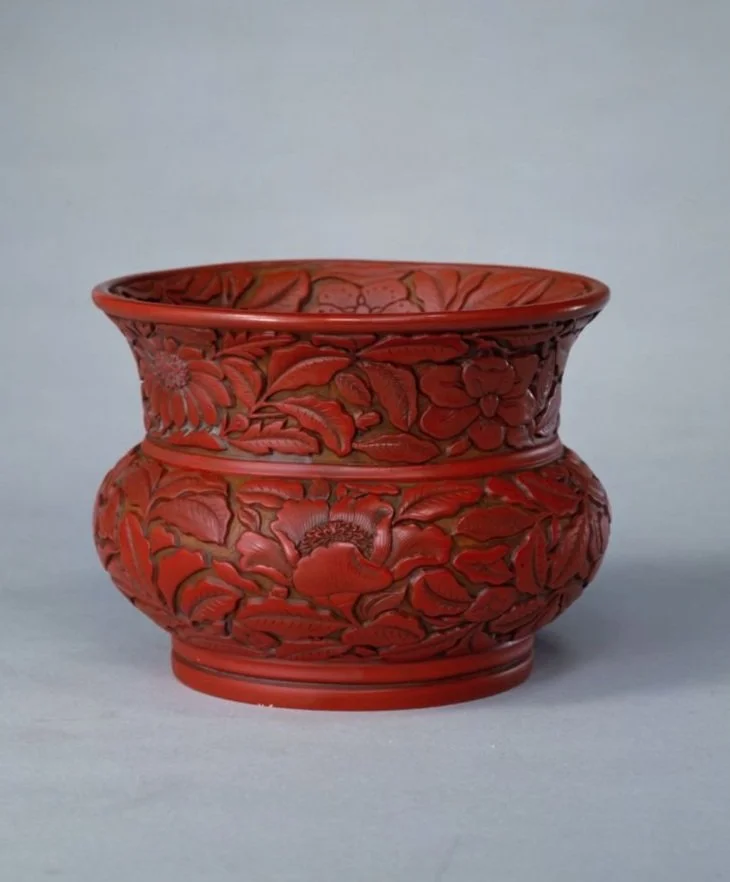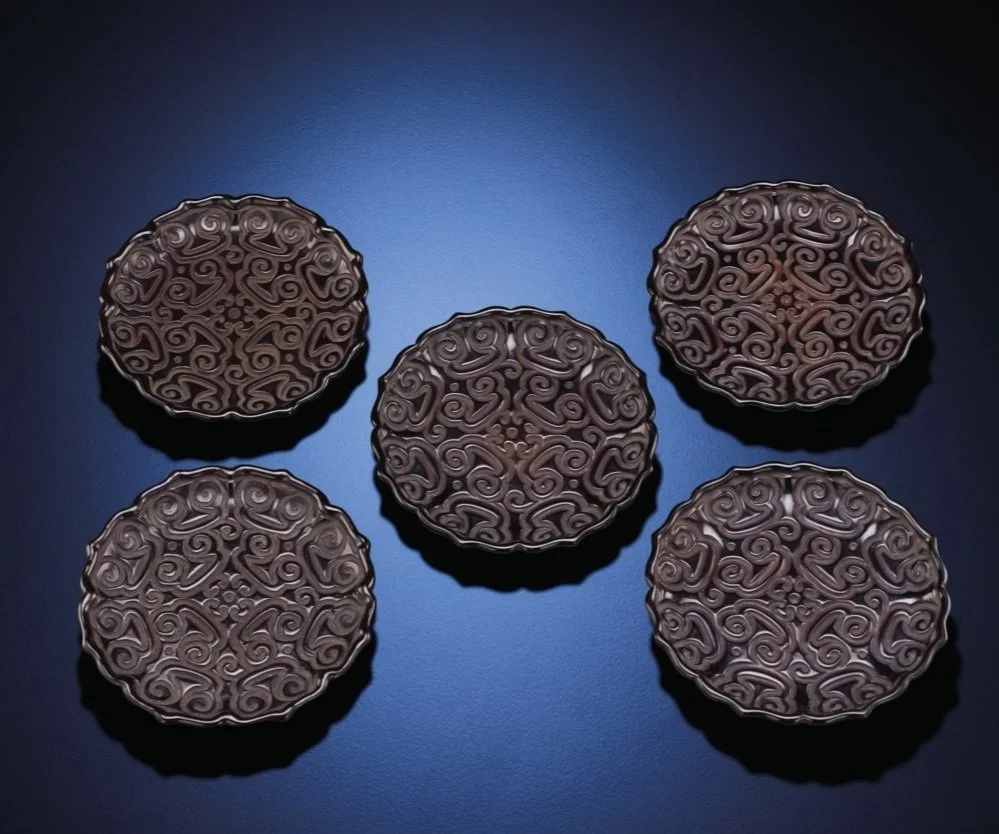WOOD DRAGON AND LACQUERWARE-INSPIRED CHARCOAL MOONCAKES
Welcome to fall! As the Mid-Autumn Festival approaches, we are thrilled to introduce a creation that embodies the essence of this lunar year: our Wood Dragon and Lacquerware-Inspired Charcoal Mooncakes.
Tīxī (剔犀) and Other Types of Lacquer Carving Techniques (雕漆)
Carved lacquer is considered one of the most classic techniques in Chinese lacquer craft, though it emerged relatively late compared to the long history of various lacquer techniques in China. The earliest known representative lacquerware are from the Neolithic Period, including a red-lacquered wooden bowl from the Hemudu Site in Yuyao, a lacquered wooden bow from the Kuahuqiao Site in Xiaoshan, Hangzhou, and lacquerware fragments from the Jingtoushan Site in Yuyao, along with other lacquered items or their remnants. Most of these early lacquerware were made with wooden cores and coated with red or black lacquer. The materials and techniques were relatively rough, and the decorations were simple. Over time, the craft evolved to include lacquer coating (髹涂) inlaid with jade. For example, an artifact with jade inlays from the Liangzhu Culture Site in Hangzhou is a typical example of this development.
From the prehistoric era to the pre-Qin period, techniques such as lacquer coating, inlaying, painting, and interior lining metal mounts developed and rapidly advanced. By the Qin and Han dynasties, painted and lined lacquerware were prospering , and lacquerware with non-wood bases had been produced in large quantities. It is noteworthy that the technique of lacquer carving may have appeared during the Han and Three Kingdoms period. An example is a ruyi cloud-patterned round lacquer box with “Tīxī” (剔犀) carving, which was donated by the Li Family to the Shanghai Museum in 2018 and is believed to date back to the Han to Three Kingdoms period.
Tixi is one of the lacquer carving techniques. According to On Lacquer Decoration (Xiushilu, 《髹飾錄》, by the late Ming-period scholar and lacquering master Huang Cheng 黃成), the only surviving traditional Chinese book on the art of lacquerwork, Tixi is described as the following,
Tixi can have red surfaces, black surfaces, or transparent purple surfaces. Sometimes there are red lines against black backgrounds, or black bands against red backgrounds, or tricolour rotating colours. The patterns usually feature loosely carved abstract designs like sword loops, ribbon loops, concentric circles, key patterns, and cloud hooks. Purely red pieces are not considered ideal.
With endnotes,
This method originated from the craft of Xīpí (犀毗, which refers to marbled lacquer, which resembles the hide of a rhinoceros) and became extremely sophisticated and refined over time. The layers of different colours are thick, and the designs are carved into them, hence the name. The term ‘tricolour layering' refers to the layering of red, yellow, and black. Using green was not part of the traditional method. Tixi has variations, including shallow concave (i.e., wide U-shaped) and steep, deep (i.e., or V-shaped) carvings.
From this, we can see the classic characteristics of ancient Tixi technique: firstly, the layers of lacquer are in different colours, and secondly, the carved patterns are primarily abstract geometric designs. Lacquerware decorated with Tixi carvings became highly popular during the Song and Yuan dynasties. A famous domestic example of such works is a series of Tixi lacquerware unearthed from the Southern Song tombs in Chayuan Hill, Fuzhou, Fujian, in 1986. Outside China, significant examples include a Song dynasty Tixi round tray held at the Tokyo National Museum, and a series of Song dynasty Tixi items in the Nezu Museum collection. The decoration of these Tixi pieces typically features classic themes, with geometric patterns like the ruyi-cloud pattern being predominant. However, there were also Song dynasty pieces with floral and bird motifs as decorative themes. For example, the Zhejiang Provincial Museum houses an elegant Tixi lacquer cosmetic box adorned with peony patterns, where black lacquer contrasts elegantly with red lines.
Mooncake Inspiration: A Set of Five Small Black Tīxī Lacquer Bracket-lobed Dishes, Song Dynasty (960–1279). Sold at Christie’s Hong Kong, 30 Nov2011, lot 3047.
Mooncake Inspiration: Tīxī Round dish, South Song Dynasty, Tokyo Museum
Besides tīxī, Huang Cheng also also documents other carved lacquer techniques in his On Lacquer Declaration, such as tīhóng (red carving), tīhuáng (yellow carving), tīlü (green carving), tīheī (black carving), and tīcǎi (multi-coloured carving). Among these, tīhóng, or red lacquer carving, is the most common form today. According to On Lacquer Declaration, during the Tang Dynasty, tīhóng lacquerware was described as “resembling brocade engraved into an intaglio in red, in an adorable rustic carving style.” By Song and Yuan, however, tīhóng lacquerware had evolved to feature “clear, well-hidden lines, smoothly rounded carvings, and fine, delicate details.” A classic example of tīhóng technique from the Song dynasty is the tīhóng phoenix-patterned box housed at the Tokyo National Museum. This rectangular box has floral decorations carved in red lacquer on all sides, representing flowers from the four seasons, while the lid features two pairs of phoenixes. The interior of the lid bears the inscription, “made by Workshop Lü of Hongfu Bridge (洪福橋呂舖造).” Hongfu Bridge was the neighbourhood named after the eponymous bridge in Lin’an (today's Hangzhou) during the Southern Song dynasty. During the Song and Yuan dynasties, lacquer art flourished in the Jiangsu and Zhejiang regions. Xitang, located in Jiaxing, Zhejiang, became a center for renowned lacquer artisans during the Yuan dynasty. In New Important Discussions about Assessing Antiques (《新格古要論》, a treatise on collecting and assessing antiques written during the early Ming period by the collector Cao Zhao 曹昭, mid-late 14th century), the author mentions several famous lacquer artisans from Xitang, such as Yang Hui, Zhang Cheng, and Yang Mao, who were known for their mastery of red lacquer carving craftsmanship. Several existing pieces inscribed with “Made by Yang Mao” include the carved.
Red acquerware spittoon with floral motif (Yongle reign) at the Palace Museum.
A Tribute to the Year of the Wood Dragon
This lunar year is special - the Year of the Wood Dragon, a symbol of strength, creativity, and renewal. The Wood Dragon is known for its energy, innovation, and growth, making this the perfect time to celebrate with something equally unique and powerful. Our mooncakes, inspired by this celestial creature, reflect its dynamic nature and deep connection to wood, one of the five elements in Wuxing.
The Significance of Wood in Wuxing
In Wuxing, wood represents life, growth, and the potential for transformation. It is associated with spring and new beginnings—qualities that resonate with both the Wood Dragon and the spirit of the Mid-Autumn Festival. Each mooncake embodies this philosophy, offering a taste experience that’s rooted in tradition while embracing innovation.
Lacquerware: A Timeless Craft
Our mooncakes draw inspiration from art of lacquerwork, where wood is the material most commonly used for the base or inner core of lacquerware, to celebrate the mid-autumn festival of the Year of the Wood Dragon. Lacquer is meticulously applied over wood to create stunning, enduring pieces of art. Learn more about our inspiration : the delicate art of carving lacquer and the ‘Ti Xi’ craft, a technique that involves layering and carving lacquer to reveal stunning designs. This intricate craftsmanship mirrors the care and dedication we pour into each mooncake.
Charcoal and Black Rice Mooncakes: A Modern Twist
Besides simulating black tixi lacquerware, the addition of natural charcoal brings a earthy flavor to the dough of the mooncake skin, offering a perfect counterbalance to the sweet filling. This modern
twist on a traditional delicacy reflects the transformative nature of the Wood Dragon and the power of innovation.
Inspiration: A Set of Five Small Black Tixi Lacquer Bracket-lobed Dishes, Song
Celebrate this Mid-Autumn Festival with a creation that honors the symbolism of the Wood Dragon and the timeless artistry of lacquerware. Order now to share this extraordinary gift with your loved
ones, and let’s welcome the full moon with something truly special. Wishing you a joyful and prosperous Mid-Autumn Festival!
Introducing Frosty Moon TM - 霜月: our in-house mooncake and sweets line by Chinese Street Market
李商隐《霜月》
初闻征雁已无蝉,百尺楼高水接天。
青女素娥俱耐冷,月中霜里斗婵娟









